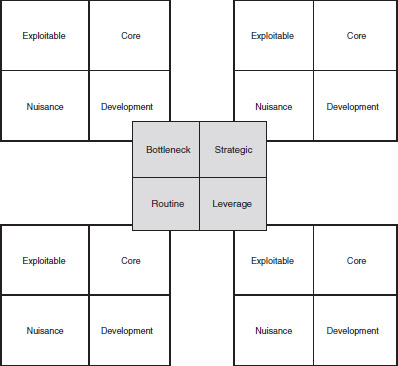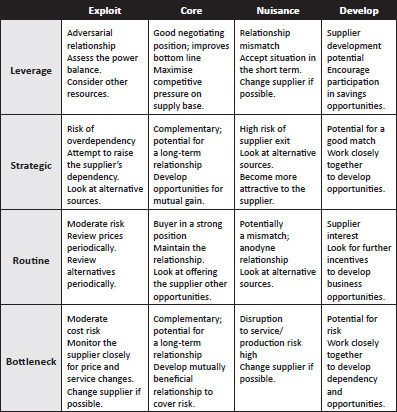Activity 21
Dutch windmill
Overview
Professor Arjan Van Weele developed the idea of the Dutch windmill framework in the early 2000s. As a combination of the Kraljic portfolio analysis and supplier preferencing matrices, it defines 16 different types of business-to-business relationships by assessing the level of buyer-supplier interdependence that exists, together with the subsequent impact this may have upon possible category strategies.
By exploring the relationship from the perspective of both parties, it is posited that a better understanding of leverage may be gleaned, supplier-buyer collaboration may evolve and overall delivery of category management benefits, such as cost savings, will be improved.
Elements
The relationships that are produced as a result of correlating the two matrices are detailed in Figure 4.5, alongside probable actions that buyers could undertake in order to expand their overall competitive position:
So what?
This framework is regarded as an excellent way of ‘guesstimating’ the relative amount of power and hence leverage that exists within the buyer-supplier dyadic. It is held as an essential tool within the category management process and can be used to aid category strategy advancement, as well as function as an early indicator of those suppliers where the biggest benefits are likely to occur.
It also helps the category project team create a rounded view of the supply relationship, rather than a more traditional, one-dimensional perspective, and therefore may support greater collaboration between the two as appropriate.
Category management application
- Supports the development of the category strategy
- Identifies a range of likely sourcing actions
- Can support prioritisation activities
- Helps assess the potential for negotiation leverage
- Can assist the development of buyer-supplier collaboration
Limitations
This framework suffers from all of the combined limitations of the Kraljic portfolio analysis and supplier preferencing models. Although the model is particularly popular with consultants, it can become a resource-intensive exercise for practitioners, and as a result there is a tendency for some to take shortcuts in order to reduce the process, which can diminish the usefulness of the output.
For an in-depth critique of procurement segmentation models, readers should consider the writings of Professor Andrew Cox. Despite there being a few basic flaws in his arguments (as well as in the practicality of his application), there is a degree of validity in his hypotheses.
Template
The following template can be used to support the supplier segmentation process:
- Template 21: Dutch windmill

